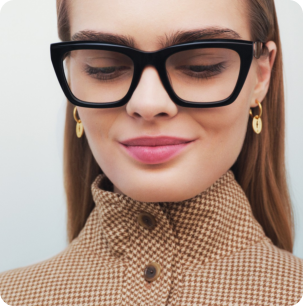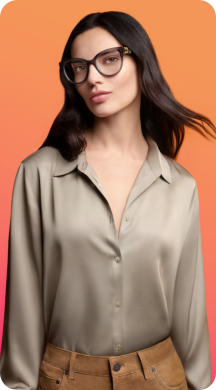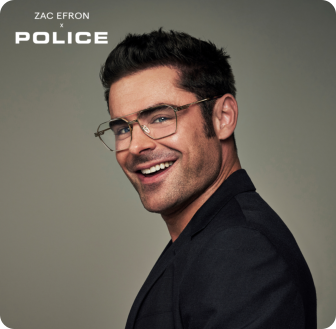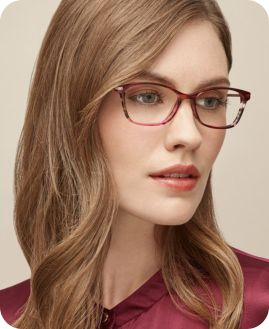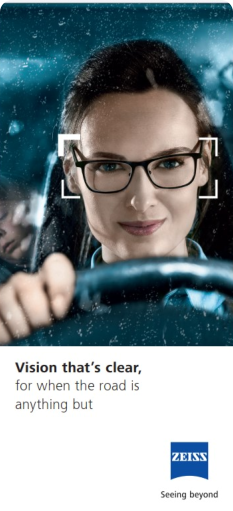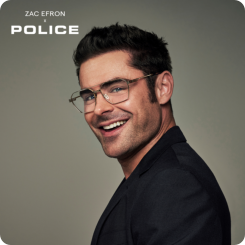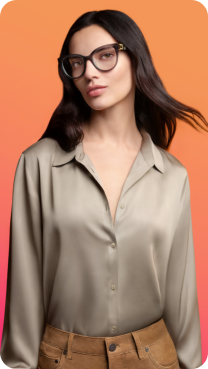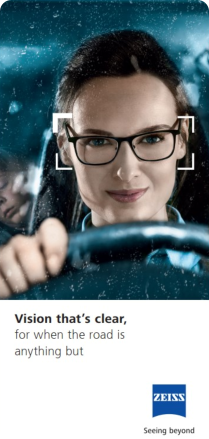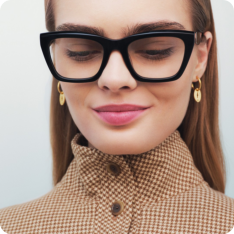“Change is the only constant”… In today’s fast-paced world this is self-evident; clothing, cars,
communications, hairstyles, computers; all are continually being improved, updated and modernised. The
world of spectacle frames is no exception!
It is not just the ‘look’ or fashion of frames that changes over time; better
design, new materials and improved manufacturing techniques all help to
create better spectacle frames that we are happier wearing.
As with clothing, it is the overall style that is a frame's most noticeable
asset. It is often said that a spectacle frame has more of an effect on our
overall appearance than an item of clothing can. With this in mind, it is not
surprising to find that some of the names that are most closely associated
with fashion and design are also very much involved with eyewear; Nina
Ricci, Furla, Police, Lozza, Mulberry, Enrico Coveri... the list could go on and
on! They all have a reputation for style and quality, and all produce a range of well-made frames.
Of course there are 'names' that many of us haven't heard of. There are many European frame manufacturers that are
household names in other countries, yet are seldom heard of in the UK. Frame makers
like Rodenstock, Marchon, Otto and People are well-known on the Continent, and
continue to provide spectacles wearers with quality frames.
We supply frames from all over the world so don't be surprised if there are some names that you haven't heard of.
We are very choosy over the frames we supply, so don’t expect to see the usual ‘High Street’ brands. Why not call in
and have a browse through the latest additions to our frame collections? New frames are arriving almost weekly! The
new sustainable eyewear ranges from Eco Conscious and Coral Eyewear are here, too.
If you thought that fashion was fast-changing, then you might be in for a shock;
spectacle lens design is no different. New materials, designs and coatings are
announced by laboratories to the optical profession almost weekly.
One of the biggest changes over recent years have been the introduction of higher index materials. These are materials
with a refractive index higher than 'standard' glass or plastic lenses. Using such material in spectacles leads to a thinner
lens.
With continuing research into lens design, the use of carefully calculated aspheric surfaces in conjunction with higher
index materials makes a lens even thinner, flatter and lighter. Most quality lens laboratories now use both methods,
sometimes in conjunction to create lenses that not only correct vision more effectively, but look more attractive also.
Another way to improve the optical performance of any lens is to incorporate an anti-reflective coating. These coatings
are used on spectacle lenses for the same reason that they are used on cameras, binoculars and other pieces of optical
equipment; they improve the transmission of light by reducing front and back surface reflections. They have been
available for several years, but recently the quality has improved dramatically - many are now more durable than a basic
lens, with impressive guarantees to back-up the claims of increased robustness. Some incorporate various elements to
enhance vision in certain circumstances, to protect the eye against certain harmful wavelengths of radiation. They can be
made in clear or photochromic (colour-changing) materials.
These modern filters produce a 'crisper' image with a higher image contrast and much reduced reflection from the lens surface. The improvement in vision is
noticeable in nearly all situation but the most dramatic improvement occurs at night when annoying reflections and 'ghost-images' from lights can be a real
distraction with uncoated lenses - particularly when driving. You won't find many opticians
wearing lenses without an anti-reflective coating!
One area of lens technology where there is ever-continuing development and improvement
is the design of progressive addition lenses (also known as multifocals or vari-focal lenses).
Patients are often amazed at the number of different progressive lenses available. Most
manufacturers make a whole series of designs; from ‘budget’ lenses (often based on older
designs) to highly customised lenses with far superior optics. Progressive lenses start life as
a complex set of equations plotting the constantly varying changes in curvature over the
surfaces of the lens. It was the advent of computer-controlled surfacing equipment that led to
the improved optics of the modern progressive lens. This is area of development where the mathematicians develop new designs before the technology exists
to turn the equations into reality! Although most people need a progressive lens to cover all distances from infinity to close-up, this isn’t necessarily the best
solution. Some of the latest research has led to types of lenses known as ‘occupational’ progressives. These are specifically aimed at intermediate and near
use, and some of these can be the perfect solution for those of us who spend most of our time using computers, offering a much wider field of view than
regular progressive lenses.
The very latest spectacle lens advance has been the ability to ‘tailor’ the optics of your spectacle lens to an
incredible level of accuracy. We have a number of pieces of equipment that enable us to take highly detailed
facial measurements for this new breed of highly customised lenses. We also take into account the way your
frame fits on you personally, and the way your eyes rotate and are positioned behind the frame of your choice.
This enables lenses to be made to an incredible level of customisation resulting in extremely accurate vision.
Like any precision-made optical device, your lenses will need to be looked after correctly if you are to get the
best from them. A little time spent looking after your lenses can add years to the ‘life-expectancy’ of your
spectacles! Click here for some advice about looking after your lenses.
Further information about modern lenses can be found at the various manufacturers' sites on our links page...
just remember that manufacturers can find it hard to be unbiased about their own lenses. It's always worth
checking with an independent optician before making up your mind about that new pair of hi-tech lenses!
“Change is the only constant”… In today’s fast-paced world this
is self-evident; clothing, cars, communications, hairstyles,
computers; all are continually being improved, updated and
modernised. The world of
spectacle frames is no
exception!
It is not just the ‘look’ or fashion
of frames that changes over
time; better design, new
materials and improved
manufacturing techniques all
help to create better spectacle
frames that we are happier
wearing.
As with clothing, it is the overall
style that is a frame's most
noticeable asset. It is often said that a spectacle frame has
more of an effect on our overall appearance than an item of
clothing can. With this in mind, it is not surprising to find that
some of the names that are most closely associated with
fashion and design are also very much involved with eyewear;
Nina Ricci, Furla, Police, Lozza, Mulberry, Enrico Coveri... the
list could go on and on! They all have a reputation for style and
quality, and all produce a range of well-made frames.
Of course there are
'names' that many of us
haven't heard of. There
are many European
frame manufacturers that
are household names in
other countries, yet are
seldom heard of in the
UK. Frame makers like
Rodenstock, Marchon,
Otto and People are well-known on the Continent, and
continue to provide spectacles wearers with quality frames.
We supply frames from all over the world so don't be surprised
if there are some names that you haven't heard of. We are
very choosy over the frames we supply, so don’t expect to see
the usual ‘High Street’ brands. Why not call in and have a
browse through the latest additions to our frame collections?
New frames are
arriving almost weekly!
The new sustainable
eyewear ranges from
Eco Conscious and
Coral Eyewear are
here, too.
If you thought that
fashion was fast-
changing, then you
might be in for a
shock; spectacle lens
design is no different. New materials, designs and coatings are
announced by laboratories to the optical profession almost
weekly.
One of the biggest changes over recent years have been the
introduction of higher index materials. These are materials
with a refractive index higher than 'standard' glass or plastic
lenses. Using such material in spectacles leads to a thinner
lens.
With continuing research into lens design, the use of carefully
calculated aspheric surfaces in conjunction with higher index
materials makes a lens even thinner, flatter and lighter. Most
quality lens laboratories now use both methods, sometimes in
conjunction to create lenses that not only correct vision more
effectively, but look more attractive also.
Another way to improve the
optical performance of any lens
is to incorporate an anti-
reflective coating. These
coatings are used on spectacle
lenses for the same reason that
they are used on cameras,
binoculars and other pieces of
optical equipment; they
improve the transmission of
light by reducing front and back
surface reflections. They have
been available for several
years, but recently the quality
has improved dramatically -
many are now more durable
than a basic lens, with
impressive guarantees to back-
up the claims of increased robustness. Some incorporate
various elements to enhance vision in certain circumstances,
to protect the eye against certain harmful wavelengths of
radiation. They can be made in clear or photochromic (colour-
changing) materials.
These modern filters produce a 'crisper' image with a higher
image contrast and much reduced reflection from the lens
surface. The improvement in vision is noticeable in nearly all
situation but the most dramatic improvement occurs at night
when annoying reflections and 'ghost-images' from lights can
be a real distraction with uncoated lenses - particularly when
driving. You won't find many opticians wearing lenses without
an anti-reflective coating!
One area of lens technology where there is ever-continuing
development and improvement is the design of progressive
addition lenses (also known as multifocals or vari-focal lenses).
Patients are often amazed at the number of different
progressive lenses available. Most manufacturers make a
whole series of designs; from ‘budget’ lenses (often based on
older designs) to highly customised lenses with far superior
optics. Progressive lenses start life as a complex set of
equations plotting the constantly varying changes in curvature
over the surfaces of the lens. It was the advent of computer-
controlled surfacing equipment that led to the improved optics
of the modern progressive lens. This is area of development
where the mathematicians develop new designs before the
technology exists to turn the equations into reality! Although
most people need a progressive lens to cover all distances
from infinity to close-up, this isn’t necessarily the best solution.
Some of the latest research has led to types of lenses known
as ‘occupational’ progressives. These are specifically aimed at
intermediate and near use, and some of these can be the
perfect solution for those of us who spend most of our time
using computers, offering a much wider field of view than
regular progressive lenses.
The very latest spectacle lens advance has been the ability to
‘tailor’ the optics of your spectacle lens to an incredible level of
accuracy. We have a number of pieces of equipment that
enable us to take highly detailed facial measurements for this
new breed of highly
customised lenses. We
also take into account the
way your frame fits on you
personally, and the way
your eyes rotate and are
positioned behind the
frame of your choice. This
enables lenses to be made
to an incredible level of
customisation resulting in extremely accurate vision.
Like any precision-made optical device, your lenses will need to
be looked after correctly if you are to get the best from them.
A little time spent looking after your lenses can add years to
the ‘life-expectancy’ of your spectacles! Click here for some
advice about looking after your lenses.
Further information about modern lenses can be found at the
various manufacturers' sites on our links page... just
remember that manufacturers can find it hard to be unbiased
about their own lenses. It's always worth checking with an
independent optician before making up your mind about that
new pair of hi-tech lenses!
